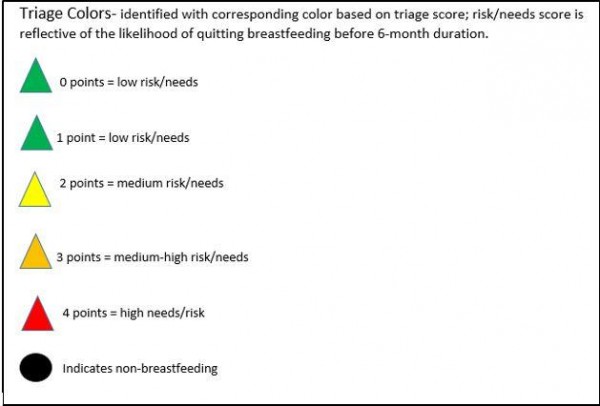Our program was designed to address breastfeeding rates in our community while addressing barriers to care. Staff designed a triage tool that was used to score lactation assistance referrals that came in to our office from local hospitals and OB/GYN providers based on identified determinants of health. In order to increase breastfeeding rates in the community, BBPH staff had to focus on parents that were at higher risk for early discontinuation of breastfeeding. Instead of offering equal services to all parents, BBPH focused on providing equitable services that aimed to remove barriers to care. BBPH focused on providing client-centered care, motivational interviewing, and creating rapport rather than providing a universal program to clients. Populations that were affected by the program included parents that sought lactation services through BBPH. The intended effect of the program was to increase breastfeeding rates overall, by providing equitable lactation services to each parent. It was the experience of lactation professionals at BBPH that parents at high-risk for early discontinuation of breastfeeding were more likely to receive subpar or minimal lactation services. The reason for this was often their social and physical determinants of health.
BBPH’s program aimed to address barriers to care based on social and physical determinants of health by utilizing a triage system. Each referral that was sent to BBPH for lactation services was scored based on several social and physical determinants of health. Based on triage score, BBPH staff could determine risk level of each parent and, in turn, prioritize which parents needed to be seen first and those that could wait without detriment to their lactation goals. The triage tool utilized the following determinants: marital status, previous pregnancy, age, and geographical location/housing status. Each determinant that was identified on a parent referral equaled a point. For example, single, primipara, age less than 30 years, and renting an apartment or home would equal a risk score of 4 and would take immediate priority for lactation staff. Each category was color-coded and identified as the following: 0 points, low risk, green; 1 point, low risk, green; 2 points, medium risk, yellow; 3 points, moderate risk, orange; 4 points, high risk, red. BBPH, local health department, collaborated with the North Dakota Department of Health to determine project goals. The project was initiated in 2017 and has been utilized daily since then.
Initially, breastfeeding rates in our community declined but this was seen as a positive factor for program staff. The reason why breastfeeding rates initially declined was because we were seeing more high-risk clients in our practice. We continued to assist everyone in our community that sought lactation assistance, but utilizing the triage system allowed us to focus the majority of our resources on parents that were at the highest risk for early discontinuation of breastfeeding/lactation. In addition, project staff reported the level of education, care, and attention our target population required was more in depth than low-risk parents. Lactation consultants also reported more no-show appointments, cancellations, and increased difficulty in getting a hold of clients. It is understood by program staff that these difficulties in getting a hold of clients are due to many factors, including social and physical determinants of health. Program staff worked outside of their norm by doing more lactation consults in the office, at parks, virtually, and when was convenient for parents. At least one lactation counselor was scheduled to be available during all business hours so lactation visits could be made readily. On average, BBPH receives between 1,000 and 1,200 referrals for lactation services annually.
Staff buy-in and education is imperative when making advancements to an existing program or service. Initially, staff that had been working with the existing program shared concerns about changing the process. Staff felt that the triage system was not helpful to all parents and there could be many different scenarios that did not fit into the triage categories. For instance, a parent that was married, over 30 years of age, and had children at home but struggled to breastfeed and required assistance. After providing education and training on equity, staff were more understanding of the process. It was important to stress that all parents are important, but some parents need more and/or different resources than others.



